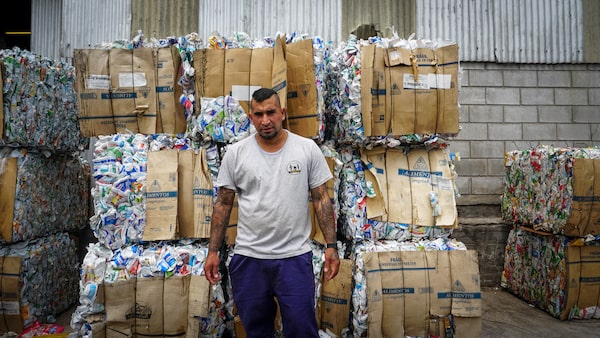
Alejandro Gonzalez works at Las Madreselvas, a recycling co-operative in Buenos Aires that was founded after Argentina's economic collapse in 2001. He sees echoes of that crisis in the economic upheaval of the COVID-19 pandemic.Natalie Alcoba/The Globe and Mail
Alejandro Gonzalez is proof of what can rise out of the ashes. He was just a child scavenging for cardboard to sell in December, 2001, when Argentina was thrust into a massive economic tailspin that left a trail of devastation.
Five presidents in 11 days. The largest foreign default in world history. A freeze on bank deposits. An abysmal devaluation of the currency. Legions of workers unemployed. Widespread protests, looting and a brutal crackdown by the police that resulted in 39 deaths.
For Mr. Gonzalez, life was already lived on the margins back then. After the collapse, his family streamed into the capital city of Buenos Aires and set up camp with the masses, insisting that authorities see their desperation to put food on the table.
Twenty years later, Mr. Gonzalez walks among the stacks of cardboard and plastic bottles in the recycling co-operative called Las Madreselvas that was created by collectors like him in the wake of the meltdown. It’s one of hundreds of examples of collective organization that saved lives and installed – or revived – a mantra of solidarity in Argentina.
His life has changed. He has a job he can depend on, so his own children can go to school. But the picture around him remains grim, with today’s financial crisis heightened by the COVID-19 pandemic. “Today if you go out onto the street, it feels like 2001,” he said. “Young people that should be studying but they’re out there pulling a cart [to collect recyclables] with their parents because they don’t have anywhere to stay. It’s the same thing we lived through.”
This is the sombre note on which Argentina marked the anniversary of the financial collapse of 2001 – known colloquially here as “el 2001″ – one of the most traumatic episodes in the country’s volatile history. Tributes were held across the country leading up to and on Dec. 19 and Dec. 20 – two dates that stand out in the crisis because then-president Fernando de la Rua imposed a state of siege that led to a violent crackdown on protesters by police, and his subsequent decision to abandon the presidency in a helicopter.
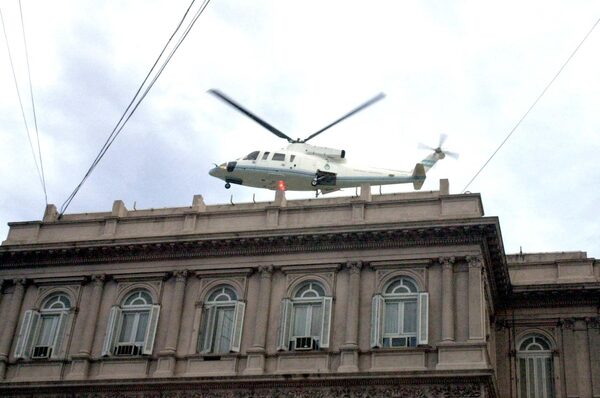
President Fernando de la Rua flees the Casa Rosada by helicopter on Dec. 20, 2001, as violent protests rage outside.ANIBAL GRECO/DYN/AFP via Getty Images
At the Casa Nacional del Bicentenario, in Buenos Aires’ Recoleta neighbourhood, an acrobatic dance troupe interpreted those tumultuous days through lifts and contortions. It drew inspiration from one of the emblematic images of the violent crackdown – that of a man by the name of Jorge Cardenas, whose crumpled and bloodied body was photographed on the steps of the National Congress.
“There was something in that image that really summarized 2001, something about the common citizen and state violence,” said director Juan Pablo Gomez, after a performance last week.
“It was the political awakening of many generations,” said Mr. Gomez, who himself went to the capital’s iconic Plaza de Mayo to protest.
“In fact, the two main parties – both the one in government and the opposition – are parties that are borne out of el 2001,” he said. “And the theatre that we do, on the margins, independent, popular and anti-system, is also steeped in 2001.”
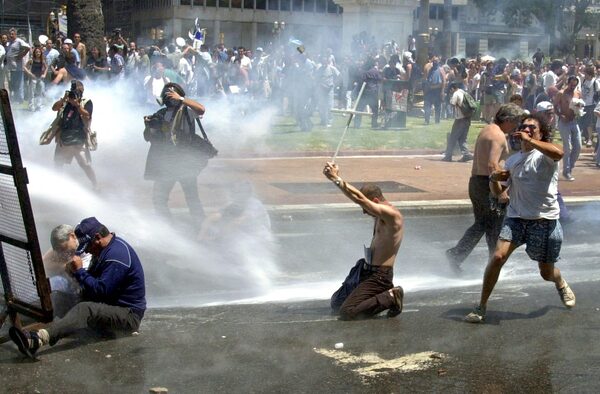
Buenos Aires, then and now: At top, a kneeling protester holds a cross as police spray him with water cannons at the Plaza de Mayo on Dec. 20, 2001. At bottom, demonstrators with flares march toward the plaza on Dec. 20, 2021.Ali Burafi/AFP/Getty Images; Agustin Marcarian/Reuters
Indeed, that national tragedy still permeates contemporary Argentina, because it launched a new era of organizing and community-building.
As people tried to smash their way into ATMs in order to recover some of their savings, neighbourhood assemblies sprung up on street corners in 2001 and 2002 to attend to urgent daily needs.
Bartering systems, public soup kitchens, community gardens and craft fairs were some of the grassroots initiatives that emerged during those hyperlocal displays of democracy.
Workers occupied and took over abandoned factories in order to keep putting food on the table, a practice that continues to this day. Faith in the state had evaporated, so people turned to each other.
“It was the push to organize,” said Erica Mansilla, 40, one of the original members of the Madreselvas co-operative that employs 600 people at a plant in the north end of the capital city. It also has a greenhouse to feed its workers, and a school to teach them how to read.
“Now we have health insurance. We are on eight-hour shifts. There is a bus that picks us up. We have meals. The changes are massive, for the better,” she said.
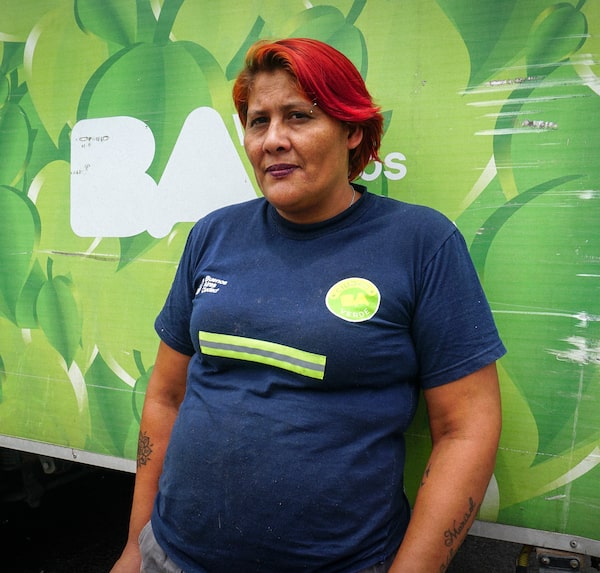
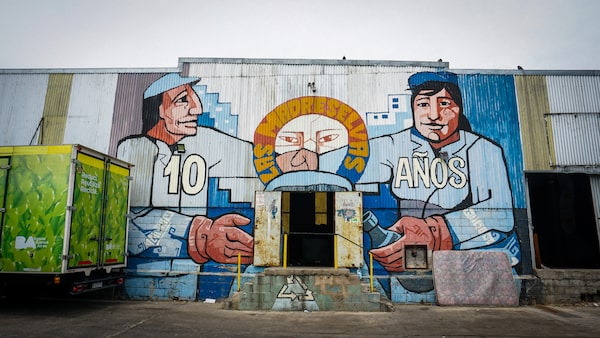
Co-operatives like Las Madreselvas are a lasting legacy of how Argentines like Erica Mansilla organized after the 2001 crash.Natalie Alcoba/The Globe and Mail
But 2001 echoes in other ways. Argentina continues to be mired in a financial crisis compounded now by the stress of the pandemic.
More than 40 per cent of its citizens (and nearly two-thirds of its children) live under the poverty line. Unemployment is at 10 per cent, inflation is expected to close out at 51 per cent this year, and its demons with debt are not over.
The government managed to renegotiate US$66-billion in privately held foreign debt last year, but it still has to come up with a new agreement on how it will pay back US$44-billion it owes to the International Monetary Fund, the international lender of last resort that many Argentines blame for tough austerity measures they have had to swallow in the past.
Tens of thousands of people have marched in the capital city this month demanding that the government not agree to new terms with the IMF. They fear another round of untenable cuts to social spending, state employees, pensions and more. Under the existing agreement, Argentina needs to pay US$19-billion each in 2022 and 2023 – figures that the government itself says it cannot afford.
“What we have now is a cumulation of economic crises that is very long, and that will take us at least a decade to recover from,” said Martin Kalos, an Argentine economist. The issue is that there is no agreement on what kind of model will pave the way to a lasting solution.
“There’s a deep feeling of exhaustion and a sense that what happened in 2001 has never been resolved,” Mr. Kalos said. “And we’re once again in a crisis that we can’t see our way out of.”
The Globe in Latin America: More reading
As Latin America’s COVID-19 pandemic heats up, communities try not to get burned again